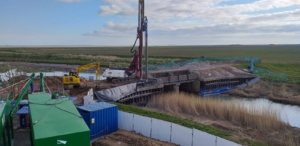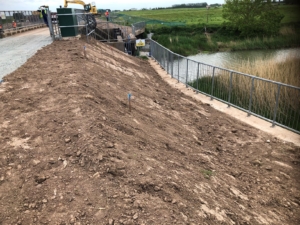CASE STUDY
Date: April 2020
Client: JBA Bentley
Project: Tetney Outfall, Grimsby
Deep Soil Mixing were contracted by design and construction Civil Engineering Contractor JBA Bentley, undertaking work for the Environment Agency, to aid flood prevention at tidal pointing doors at Tetney Outfall near Grimsby.
Prior to this project, the Environment Agency had put in place flood defence embankment initiatives but the sheet piles at the lock gate by the weir had passed their design life and needed substantial repair or
replacement.
The fact the sheet pile return walls were in a poor condition meant replacing them presented a major engineering challenge for both the permanent and temporary works. JBA Bentley wanted an alternative
solution.
The Soil Mixing Solution
Due to the engineering difficulties of the site, deep soil mixing was specified to stabilise the embankment and ground behind the existing sheet pile walls to a maximum depth of 11m.
Together with repairs to in situ piles, soil mixing dramatically improved the soil properties so that stresses on the sheet piles and anchors were reduced to extend the design life of the structure at Tetney Lock.
The Project
At the start of the project additional ground investigation works were undertaken and soil mixing trials were conducted.
Each soil sample was mixed in the Deep Soil Mixing Ltd laboratory and then tested to identify the most appropriate binder or combination of binders.
The weak soils of the embankment were then improved using Deep Soil Mixing’s bespoke double rotary mixing head that soil mixed the whole embankment and provided a solid bund that reduced the pressure on the sheet piles, supporting the entire structure and extending the design life.
The work was carried out from a base machine situated on the main access road across the tidal pointing doors and installation was carried out using a double rotary mixing head. Central embankment
columns were installed in front of the rig, in order to improve loading capabilities for the advancing rig to then install columns either side of the embankment.
Throughout the project, the work needed to comply with the Wildlife and Countryside Act 1981 – soil mixing complemented this need, given it has no adverse impact on the environment thanks to the soil being mixed in-situ with little noise and no vibration.
What are the benefits of using soil mixing?
Environmentally Friendly & Economical: Natural resources are spared as existing soil is used as aggregates. Many forms of contaminated ground can also be mixed which reduces transportation of raw materials to landfill. The use of soil mixing can also reduce construction programme and reduces carbon footprint with less vehicular movements.
Flexible: Effective on different soils, including soft soils, flood plains, contaminated land, peat, silts and alluvium etc. Flexibility also in design and application as well as installation of the soil mix not being affected by the weather. The final cured product can also be shaped, benched or battered to suit.
Reduces Construction Programme
Reduced Vibration: Soil Mixing induces very low vibrations, which reduces the potential impact to nearby utilities.
Increases bearing pressure, controls settlement and reduces permeability.







